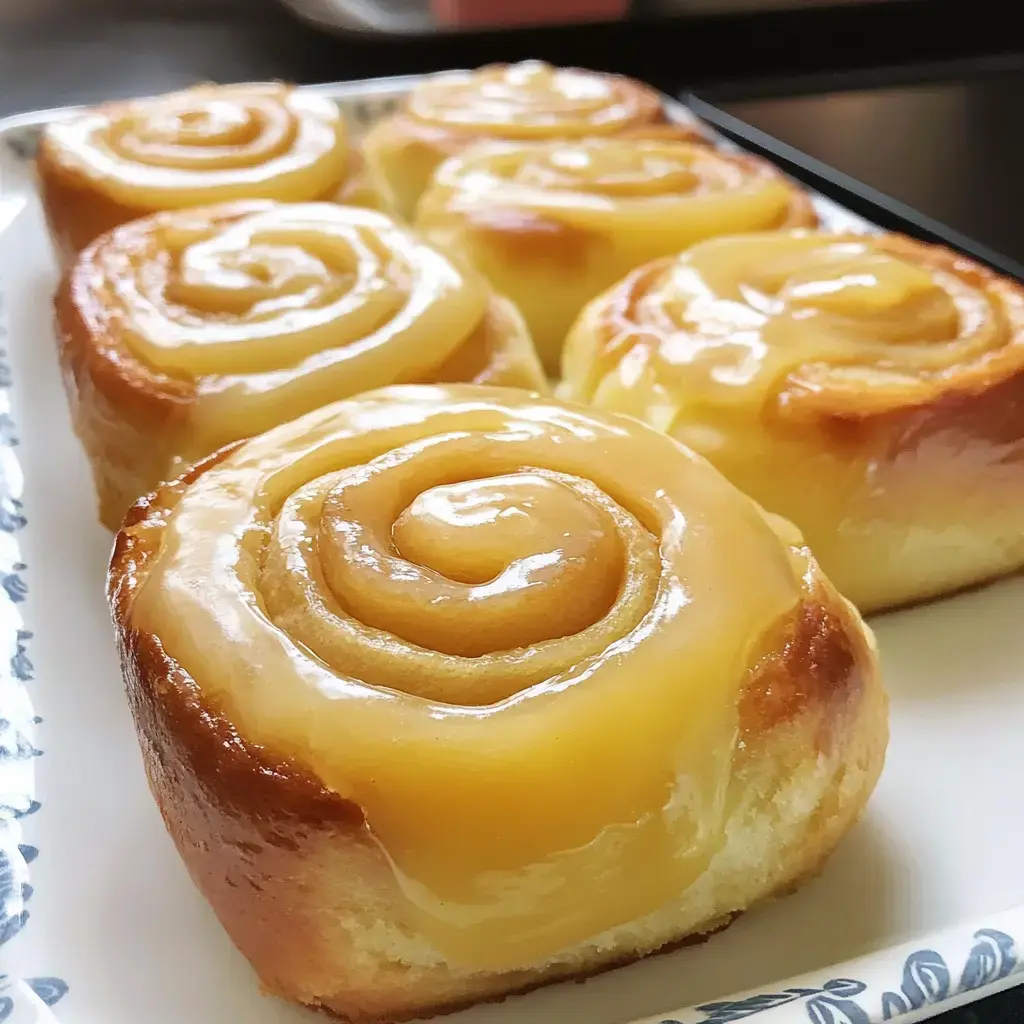 Pin it
Pin it
Lemon Curd Sweet Rolls are a delightful treat, perfect for starting your day or enjoying as a brunch favorite. With a tangy lemon curd filling and a sweet glaze, these rolls are a balance of citrusy brightness and comforting sweetness.
Why You'll Love These Rolls
These Lemon Curd Sweet Rolls are soft, fluffy, and bursting with vibrant lemon flavor. The tangy filling combined with a light, sweet glaze makes them ideal for any breakfast table or holiday brunch. They're easy to prepare and look beautiful when served fresh from the oven.
Essential Ingredients For Success
- Dough Base Components:
- ½ cup (120ml) filtered water at precisely 110-115°F (43-46°C)
- ¾ cup (180ml) whole milk at 110-115°F (43-46°C), 3.5% fat content
- 2 tablespoons (18g) instant yeast, fresh and active, stored below 75°F (24°C)
- ¾ cup (150g) granulated sugar, pure cane, free-flowing with no lumps
- ½ cup (113g) unsalted butter at 65-68°F (18-20°C), European-style (82% butterfat)
- 1 large egg at 65-68°F (18-20°C), weight 50g
- 1 teaspoon (6g) fine sea salt
- 4½ cups (540g) all-purpose flour, protein content 10-12%, temperature 68-72°F (20-22°C)
- Lemon Curd Filling:
- 10 ounces (283g) lemon curd at 65°F (18°C), smooth and spreadable consistency
- Should coat back of spoon and hold clean line when finger drawn through
- pH level 3.5-4.0 for optimal tang and set
- Glaze Components:
- 1 cup (120g) powdered sugar, 10X grade, sifted to remove all lumps
- ¼ teaspoon pure lemon flavoring, clear and concentrated
- 3-4 tablespoons (45-60ml) whole milk at 65°F (18°C)
- Final consistency should form ribbon that holds for 3 seconds before dissolving
Step By Step Instructions
- Environment Preparation
- Set room temperature to 75°F (24°C) with humidity 65-70%. Calibrate oven to 350°F (177°C). Prepare 13x9-inch pan with butter coating at room temperature.
- Yeast Activation Phase
- Combine water and milk at exactly 110-115°F (43-46°C). Add yeast and 1 tablespoon sugar. Allow to proof 5-7 minutes until foam reaches 1/2-inch height with small, uniform bubbles.
- Dough Development
- Mix wet ingredients until butter fully emulsified. Add flour gradually while maintaining dough temperature 75-78°F (24-26°C). Knead 4-5 minutes until dough passes windowpane test and springs back when pressed, leaving slight indent.
- Primary Fermentation
- Place in oiled bowl (neutral oil), cover with plastic wrap. Ferment at 75°F (24°C) for 90 minutes or until doubled (internal temperature 75-78°F/24-26°C). Dough should be puffy and light with small bubbles visible on surface.
- Shaping Protocol
- Roll dough on lightly floured surface to exactly 15x18 inches, 1/4-inch thickness. Spread lemon curd to 1/4-inch from edges. Roll from long side, maintaining even pressure. Seal seam by pinching. Cut into 12 pieces (1.5 inches each) using dental floss technique.
- Secondary Fermentation
- Arrange rolls in prepared pan with 1/4-inch spacing. Cover with plastic wrap. Proof at 75°F (24°C) for 60 minutes until rolls are touching and spring back slowly when pressed.
- Baking Specifications
- Bake at 350°F (177°C) for 15-20 minutes. Internal temperature should reach 190°F (88°C). Surface should be golden brown with slight caramelization at edges. Cool 10 minutes or until temperature drops to 115°F (46°C).
- Glaze Application
- Combine glaze ingredients until ribbon stage achieved (3-second dissolution). Apply to rolls at 110°F (43°C) for optimal absorption and shine.
Recipe Notes and Variations
- Use homemade lemon curd for a fresher, tangier flavor.
- Substitute almond milk or oat milk for a dairy-free option.
- Add poppy seeds to the dough for a lemon-poppy seed twist.
- Sprinkle grated lemon zest over the glaze for extra citrus flavor.
Storage and Reheating Tips
Store leftover rolls in an airtight container at room temperature for up to 2 days or refrigerate for up to 5 days. Reheat individual rolls in the microwave for 15-20 seconds or warm the entire tray in a 300°F oven for 10 minutes.
 Pin it
Pin it
Baking Tips for Success
- Use a kitchen thermometer to ensure liquids are at the correct temperature for yeast activation.
- Knead dough until smooth and elastic to achieve the best texture.
- Let the rolls rise fully for a fluffy, airy result.
- For a sweeter glaze, add more powdered sugar; for a thinner glaze, increase milk slightly.
Frequently Asked Questions
- → Can I make these rolls ahead of time?
Yes, you can prepare them the night before and let them do their second rise in the fridge overnight. Bring to room temp before baking.
- → Why does the milk need to be 110-115 degrees?
This temperature range activates the yeast without killing it. Too hot will kill the yeast, too cool won't activate it properly.
- → Can I use regular milk instead of coconut milk?
Yes, any type of milk works fine. The coconut milk adds richness but regular dairy milk is perfectly good too.
- → Why isn't my dough rising?
Check that your yeast hasn't expired and that your liquid wasn't too hot. Also ensure you're letting it rise in a warm spot away from drafts.
- → Can I freeze these rolls?
Yes, you can freeze them either before or after baking. If freezing before, thaw completely and let rise before baking.
